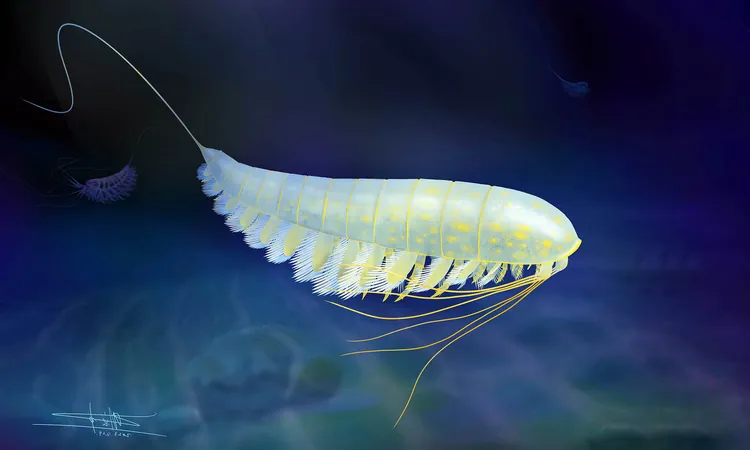
Uncovering the Golden Fossil: A 450-Million-Year-Old Arthropod Encased in Fool's Gold
2024-11-10
Author: Ming
A Deeper Look at Lomankus Edgecombei
Professor Luke Parry from the University of Oxford shared his enthusiasm about the specimen, stating, “These fossils possess a beautiful and striking golden color that makes it seem as if they could spring back to life at any moment.” This remarkable arthropod is part of a lineage that is closely related to modern-day spiders, scorpions, and horseshoe crabs, harking back to a time when megacheirans flourished in the Cambrian seas.
Megacheirans are characterized by their distinctive “great appendages,” which were likely used to capture prey. However, this new species challenges that narrative. Unlike its relatives, Lomankus exhibits reduced claw structures and long, whip-like appendages that hint at a more sensory role, possibly helping it navigate through its dark aquatic environment. Remarkably, Lomankus appears to have lived without eyes, adapting to life in deeper, low-light niches.
An Evolutionary Treasure
The discovery of Lomankus acts as a crucial puzzle piece in understanding the evolutionary history of arthropods, a group that boasts the highest diversity of species on our planet today. Professor Parry explains that the variety of specialized appendages seen in arthropods—such as the antennae of insects and the pincers of scorpions—highlight their evolutionary adaptability. “Lomankus demonstrates that rather than being a ‘dead end,’ the lineage of megacheirans continued to diversify and evolve long after the Cambrian period,” he said.
Further examination of the fossil reveals unique anatomical traits. According to Professor Yu Liu from Yunnan University, features such as the distinct plate structure beneath the head, which is associated with the mouth, suggest clear evolutionary relationships with earlier megacheirans from the early Cambrian of China.
The Fossilization Process and Its Implications
This remarkable fossil was unearthed in a notable geological site in New York known for “Beecher’s Trilobite Bed.” This location has gained fame due to its rich assemblage of trilobites, with the unique low-oxygen conditions contributing to the exceptional preservation of fossils through pyritization.
The process of pyritization has allowed for an intricate level of detail to be captured in these fossils, which can now be visualized using advanced techniques such as CT scans. This method unveils hidden anatomical features that are critical for understanding life in the ancient oceans.
Professor Derek Briggs from Yale University noted that the swift replacement of delicate features with pyrite, before they deteriorated, offers crucial insights into the history of life on Earth, providing evidence of the evolutionary steps taken by marine organisms.
Conclusion: A Window into the Past
The unveiling of Lomankus edgecombei not only sheds light on an ancient ecosystem but also showcases the incredible adaptability and evolutionary journey of arthropods. As scientists continue to explore fossils like these, each discovery helps illuminate the rich tapestry of life that has existed on our planet for millions of years. This golden fossil is more than just a historical artifact; it is a fascinating glimpse into a diverse and ancient world that once thrived beneath the waves.



 Brasil (PT)
Brasil (PT)
 Canada (EN)
Canada (EN)
 Chile (ES)
Chile (ES)
 Česko (CS)
Česko (CS)
 대한민국 (KO)
대한민국 (KO)
 España (ES)
España (ES)
 France (FR)
France (FR)
 Hong Kong (EN)
Hong Kong (EN)
 Italia (IT)
Italia (IT)
 日本 (JA)
日本 (JA)
 Magyarország (HU)
Magyarország (HU)
 Norge (NO)
Norge (NO)
 Polska (PL)
Polska (PL)
 Schweiz (DE)
Schweiz (DE)
 Singapore (EN)
Singapore (EN)
 Sverige (SV)
Sverige (SV)
 Suomi (FI)
Suomi (FI)
 Türkiye (TR)
Türkiye (TR)
 الإمارات العربية المتحدة (AR)
الإمارات العربية المتحدة (AR)